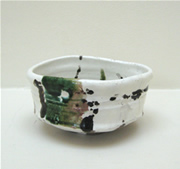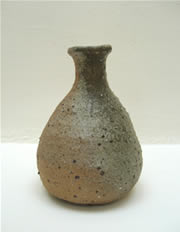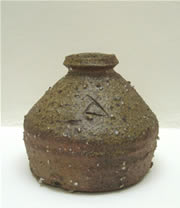SHIRO TSUJIMURA (b.1947)

Shiro Tsujimura is a major modern Japanese potter who makes exciting and innovative use of Japanese ceramic traditions. He employs Oribe, Bizen and Shigaraki forms, to create dynamic anagama, or wood fired, pots with gritty textured surfaces and free flowing glazes.
Above: Shiro Tsujimura, Devon, 1993
Photo © Nobuo Okawa
Read more...
Summer 1993 in Devon
The place where Japanese potter Shiro Tsujimura spent the three months of his English visit is idyllic — in the far west of Devon, near Okehampton, the landscape is hilly and wooded. In front of the house where he stayed, and the studio converted for his use, is a Zen-type rock garden and beyond that a sharp drop to a small lake bordered by trees. In the distance, one can see deer, and buzzards fly low over the house. The drama of this setting and the extremes of weather the day I was there — hot September sun punctuated by monsoon downpours of rain — seemed to reflect the whole character of this potter, his unpredictable nature and the forceful quality of what he makes.
In spite of a large number of pots made over some two months, there was really little routine during Tsujimura’s stay. The regular meals many of which Tsujimura cooked himself, were the rare constant for his accommodating hosts, Chuck and Sue Schwartz. This impulsive character might make pots all day or suddenly drive off in the car to visit a local church or collect materials. His admiration of the stonework of Devon churches, and appreciation of the landscape around Lydford reveals much about Tsujimura’s aesthetic, a deeply rooted understanding of organic texture, of the way in which time and weather affects and enriches the appearance of things. You see this in the varied surfaces of the pots, and the way in which these pots are stored after firing — in the open and left to nature. When I visited, most of the pots were sorted into groups on the gravel — wood ash vases and variously decorated teabowls collecting the rain and splashed with soil stains. One could pick one’s way through them and handle them at random, just as Tsujimura would tend to do.
Everything about the place and Tsujimura’s idiosyncratic method revealed the importance of the material source. Some clay was dredged from the Schwartz’s pond, and most of his tools he made himself, raiding any suitable kindling pile for the purpose. The kiln opening was a special ritual for potter and interested visitors, partly because of an awareness of the setting. The whole experience, of walking down the wooded path towards the kiln (as if approaching a Japanese teahouse), of examining the pots left in the long wet grass around the chamber, and of watching the unpacking, was significant in a way that is difficult to describe. I saw a number of large pots pulled out and handled in an almost cursory way, before being passed on. Freely thrown water jars and bowls, scored with his mark, had extraordinary richness of surface; coarse dark clay bodies with translucent ashglazes washing over them. These pieces revealed their qualities gradually, on close and patient inspection. Each gave its own surprises, a necessary quality for an intensely experienced potter who throws intuitively and loosely, without design, and then places each piece, seemingly at random, into the kiln, so that the natural processes will offer something new. Working in this way, Tsujimura’s contribution to the ancient traditions of Japanese potters is particularly strong and vibrant.
by David Whiting
from the catalogue accompanying Shiro Tsujimura's 1994 exhibition at Galerie Besson
Exhibitions at Galerie Besson
| Japanese Ceramics | Jan - Feb 2004 |
| Shiro Tsujimura | May - Jul 1994 |



